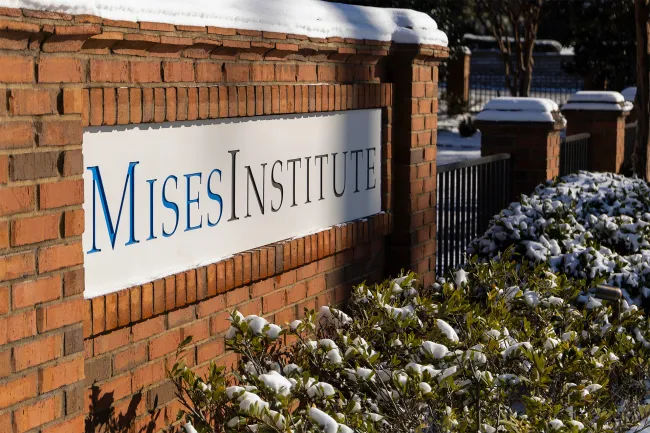For a few days during the early weeks of the current Trump administration, it appeared that the Trump team might actually try to rein in the Federal Reserve. Trump and Elon Musk hinted that they would push for an audit of the Federal Reserve, and they even suggested that they would bring in Ron Paul to serve as an advisor on the matter. More recently, though, it seems that a meaningful critique of the Fed is going the way of that imaginary trillion dollars that the Department of Government Efficiency has already given up on cutting from the federal budget. In other words, the hinted-at Fed audit has disappeared from the Trump “to do” list.
Even worse, it now is becoming clear that if the Trump team is going to attack the Fed, it’s because Trump wants more inflation from the Fed, not less. Since he was sworn in, Trump has attacked the current Fed chairman Jerome Powell at least three times for not forcing down interest rates enough. He’s done this in spite of the fact that the Fed cut rates by 100 basis points over the past year. Specifically, last fall, the Federal Open Market Committee (FOMC) reduced the target rate three times, lowering it from 5.5 percent to 4.5 percent. This was a major reduction, especially since it occurred during a period when it was hardly clear that CPI inflation was falling sustainably.
In February, though, Trump railed against Powell (and, by extension, the FOMC) for not implementing any new cuts in the Fed’s target policy rate since December. Trump wrote on Truth Social “Interest Rates should be lowered, something which would go hand in hand with upcoming Tariffs!!! Lets Rock and Roll, America!!!” Apparently, The Fed’s recent cuts to the Fed’s target rate—which requires ongoing market intervention from the FOMC—was not enough for Trump.
Then, on April 17, Trump renewed his inflationist attack, complaining in another social media post that Powell is “always TOO LATE AND WRONG,” and he insisted the Fed chairman’s “termination cannot come fast enough!” Trump even held up the highly inflationist European Central Bank as a sort of model, claiming that the Fed should be more like the ECB. This past Monday, Trump was at it again, demanding that Powell lower the target policy rate, posting on social media: “unless Mr. Too Late, a major loser, lowers interest rates, NOW.”

Trump’s word choice is telling. The refrain of “too late” has long been the battle cry of Wall Street corporate welfare queens who push for easy money while complaining that the Fed will engage in a “policy error” if it doesn’t slash rates “soon enough.” Trump is now apparently very much on that bandwagon. Of course, for people like Trump and other easy-money addicts, it’s almost always the “right time” to cut interest rates in order to “stimulate” the economy with more monetary inflation.
At this point it’s clear that hopes that Trump was going to be a hard-money guy who would rein in monetary inflation were pure wishful thinking. Trump’s preferred monetary policy is demonstrably no different from that of Biden, Obama, or George W. Bush. The “solution” for these politicians is always more easy money, in the form of lower interest rates.
Why Trump Needs More Easy Money
This should not surprise us, though, since Trump wants to lower interest rates for political reasons just as his predecessors did. For one, Trump’s profligate budget policies continue to run up large deficits, and there are no plans for any major cuts in deficit spending, in spite of the quickly unraveling promises made by the so-called Department of Government Efficiency.
So, in order to prevent interest rates on the federal debt from spiraling out of control, Trump is going to need the Fed to intervene to put some downward pressure on yields.
Secondly, Trump wants monetary stimulus to counteract the effects of his tax hikes on imports-also known as “tariffs.” Trump himself hinted at this with his February comment in which he said that lower interest rates “would go hand in hand with upcoming Tariffs!!!” From the perspective of economics, this sentence is essentially a non sequitur since there’s nothing about tariffs or low interest rates that suggests they go necessarily go “hand in hand.” Trump’s claim makes a lot of sense from a political perspective, however. Given that tariffs are just taxes, and taxes have an impoverishing effect on the economy, it seems Trump wants a more dovish Fed to create a “wealth effect” among voters. That is, low interest rates can be a political tool to paper over the real negative effects of higher tariffs—which are just taxes on Americans who want to buy imported goods.
What Trump Should be Doing
The problem with the Fed is most certainly not that Jerome Powell isn’t forcing down interest rates enough. Rather, interest rates have been far too low for far too long, augmented by the FOMC’s usual open market operations and by repeated and huge asset purchases of Treasurys and mortgage-backed securities since 2008.
Contrary to Trump’s plans for more monetary inflation, the right path is to rein in the Fed by ending the Fed’s power to purchase assets of any kind, thus greatly curtailing the Fed’s ability to manipulate interest rates. (Naturally, the end goal should be to abolish the Fed entirely.)
Unfortunately, it’s increasingly apparent that Trump has no interest in fighting the monetary policies that give us 40-year highs in price inflation in 2022, and which continue to drive up prices in housing, food, and other essentials. If anything, Trump is doubling down on those failed policies and demanding that our activist, meddling central bank do even more.


